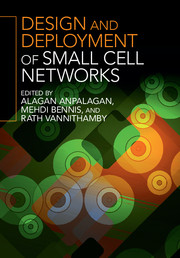Book contents
- Frontmatter
- Contents
- List of contributors
- Preface
- 1 Mobility performance optimization for 3GPP LTE HetNets
- 2 Design and performance analysis of multi-radio small cell networks
- 3 Dynamic TDD small cell management
- 4 3GPP RAN standards for small cells
- 5 Dense networks of small cells
- 6 Traffic offloading scenarios for heterogeneous networks
- 7 Required number of small cell access points in heterogeneous wireless networks
- 8 Small cell deployments: system scenarios, performance, and analysis
- 9 Temporary cognitive small cell networks for rapid and emergency deployments
- 10 Long-term evolution (LTE) and LTE-Advanced activities in small cell networks
- 11 Game theory and learning techniques for self-organization in small cell networks
- 12 Energy efficient strategies with BS sleep mode in green small cell networks
- 13 Mobility management in small cell heterogeneous networks
- 14 The art of deploying small cells: field trial experiments, system design, performance prediction, and deployment feasibility
- 15 Centralized self-optimization of interference management in LTE-A HetNets
- 16 Self-organized ICIC for SCN
- 17 Large-scale deployment and scalability
- 18 Energy efficient heterogeneous networks
- 19 Time- and frequency-domain e-ICIC with single- and multi-flow carrier aggregation in HetNets
- Index
- References
19 - Time- and frequency-domain e-ICIC with single- and multi-flow carrier aggregation in HetNets
Published online by Cambridge University Press: 05 December 2015
- Frontmatter
- Contents
- List of contributors
- Preface
- 1 Mobility performance optimization for 3GPP LTE HetNets
- 2 Design and performance analysis of multi-radio small cell networks
- 3 Dynamic TDD small cell management
- 4 3GPP RAN standards for small cells
- 5 Dense networks of small cells
- 6 Traffic offloading scenarios for heterogeneous networks
- 7 Required number of small cell access points in heterogeneous wireless networks
- 8 Small cell deployments: system scenarios, performance, and analysis
- 9 Temporary cognitive small cell networks for rapid and emergency deployments
- 10 Long-term evolution (LTE) and LTE-Advanced activities in small cell networks
- 11 Game theory and learning techniques for self-organization in small cell networks
- 12 Energy efficient strategies with BS sleep mode in green small cell networks
- 13 Mobility management in small cell heterogeneous networks
- 14 The art of deploying small cells: field trial experiments, system design, performance prediction, and deployment feasibility
- 15 Centralized self-optimization of interference management in LTE-A HetNets
- 16 Self-organized ICIC for SCN
- 17 Large-scale deployment and scalability
- 18 Energy efficient heterogeneous networks
- 19 Time- and frequency-domain e-ICIC with single- and multi-flow carrier aggregation in HetNets
- Index
- References
Summary
Multi-layer heterogeneous network (HetNet) deployments including small cell base stations (BSs) are considered to be the key to further enhancements of the spectral efficiency achieved in mobile communication networks [1]. Besides the capacity enhancement due to frequency reuse, a limiting factor in HetNets has been identified as inter-cell interference. The 3rd Generation Partnership Project (3GPP) discussed inter-cell interference coordination (ICIC) mechanisms in long term evolution (LTE) Release 8/9 [2]. LTE Release 8/9 ICIC techniques were introduced to primarily save cell-edge user equipments (UEs). They are based on limited frequency domain interference information exchange via the X2 interface, whereby ICIC related X2 messages are defined in the 3GPP standard [3]. In LTE Release 8/9 ICIC, a BS provides information about set of frequency resources in which it is likely to schedule DL transmissions to cell-edge UEs, for the benefit of a neighboring BS. The neighboring BS in turn avoids scheduling its UEs on these frequency resources.
With the growing demand for data services and the introduction of HetNets it has become increasingly difficult to meet a UE's quality of service (QoS) requirements with these mechanisms. To cope with the QoS requirements and growing demand for data services, enhanced ICIC (e-ICIC) solutions have been proposed in LTE Release 10 and further e-ICIC (Fe-ICIC) solutions to reduce cell reference signal (CRS) interference in e-ICIC techniques are discussed in LTE Release 11 [4].
In LTE Release 10 e-ICIC techniques, the focus is on time- and frequency-domain techniques and power-control techniques. While in time-domain techniques, the transmissions of the victim UEs are coordinated in time-domain resources, in frequency-domain techniques, e-ICIC is mainly achieved by frequency-domain orthogonalization. The power-control techniques have been intensively discussed in 3GPP. Hereby, power control is performed by the aggressor cell to reduce inter-cell interference to victim UEs. In 3GPP studies, e-ICIC mechanisms with adaptive resource partitioning, cell range expansion (CRE), and interference coordination/cancellation take a central stage [5].
In the following, the inter-cell interference problem in HetNets is introduced and time- and frequency-domain e-ICIC techniques are discussed based on 3GPP specifications. In addition, single- and multi-flow transmission techniques for e-ICIC and system capacity improvement are described.
Inter-cell interference in HetNets
One of the major features extensively studied for LTE Release 10, also known as LTE-Advanced, is the HetNet coverage and capacity optimization, e.g., through the use of cell-range expansion (CRE) techniques.
- Type
- Chapter
- Information
- Design and Deployment of Small Cell Networks , pp. 484 - 501Publisher: Cambridge University PressPrint publication year: 2015



